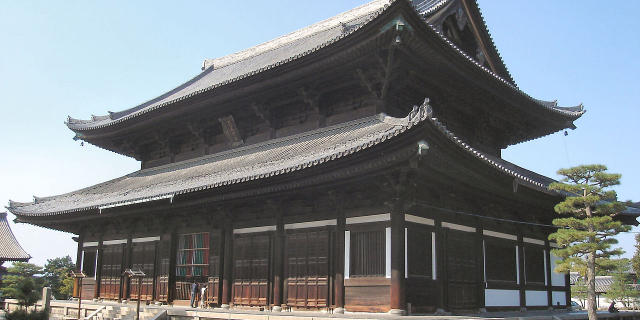一力茶屋
( Ichiriki Chaya )
The Ichiriki Teahouse (一力茶屋, Ichiriki Chaya), formerly Ichiriki Mansion (一力亭, Ichiriki-tei), is an historic ochaya ("tea house") in Kyoto, Japan. It is located at the southeast corner of Shijō Street and Hanami Lane, its entrance right at the heart of the Gion Kobu district.
It is considered an exclusive and high-end establishment; access is invitation only while its fame is often associated with the Chushingura event. The 9th teahouse proprietor is Jirou-emon Sugiura.
The Ichiriki is more than 300 years old, and has been a major centerpiece of Gion since the beginning of the entertainment district. Like other ochaya in Gion, the Ichiriki is used to hold parties (ozashiki) by geisha, the Ichiriki in particular having traditionally entertained men of political and business power.
The house is run by the Sugiura (杉浦) family, and the nameplate on the entrance gate reads Sugiura Jirou(u)emon (杉浦治郎右衛門),[a] the name of the 9th generation head.[1]
NameThe noren curtains at the entrance feature the characters ichi (一, "one") and riki (力, "strength") printed in black on a dark red ground, arranged to resemble the character man (万, "myriad, ten thousand"). It is said that the establishment was originally called yorozuya (万屋, general store), but in the play Kanadehon Chūshingura (仮名手本忠臣蔵) (a telling of the story of the forty-seven rōnin, based on events at the house), the name was changed by splitting the character into 一 and 力, disguising the name. Due to the play being a major success, this was then adopted by the house itself, yielding the present name.[1]
The forty-seven rōninThe Ichiriki plays a part in the events of the Akō vendetta, an 18th century historical event described by some scholars as a Japanese "national legend".[2] A group of samurai became masterless (rōnin) following the ritual suicide of their daimyō, who was sentenced to death for the crime of drawing a sword and injuring a man in the Imperial Palace. Kira Yoshinaka had made a series of verbal insults towards the samurai's master, inciting his attack, but was left unpunished; as a result of this, the masterless samurai plotted to assassinate Yoshinaka for over two years.
The samurai, led by Oishi Kuranosuke, realized they would be monitored for signs they were planning to enact revenge. Thus, in an effort to dissuade the suspecting parties and Imperial spies, they sent Kuranosuke to Kyoto, who spent many nights at the Ichiriki earning a reputation as a gambler and a drunkard.[3] As Kuranosuke gave the appearance of becoming more and more relaxed and unprepared, Kira became less active in his suspicions and eventually relaxed his security. Because the Ichiriki provided the cover to mount an attack, the samurai were eventually successful in killing Yoshinaka, but were then forced to commit suicide themselves.
This story has been retold numerous times, a genre known as Chūshingura, which has served to increase the fame of the Ichiriki.
The fall of the shōgunAs modernisation spread through Japan during the final years of the Edo period, unrest also spread within the country, with the age of the shōgun coming to an end; a number of murders of foreigners had led to tension rising between Japan and the Western powers, and this international pressure led many to question the legitimacy of the shōgun's rule.[4]
Much of the plotting to overthrow the shogunate took place in secretive talks at the Ichiriki, disguised as innocent evenings with friends.[5] The plans came to fruition in 1868 when the last shōgun agreed to dissolve the shogunate at Nijō Castle.[5]
Cite error: There are <ref group=lower-alpha> tags or {{efn}} templates on this page, but the references will not show without a {{reflist|group=lower-alpha}} template or {{notelist}} template (see the help page).

































Add new comment